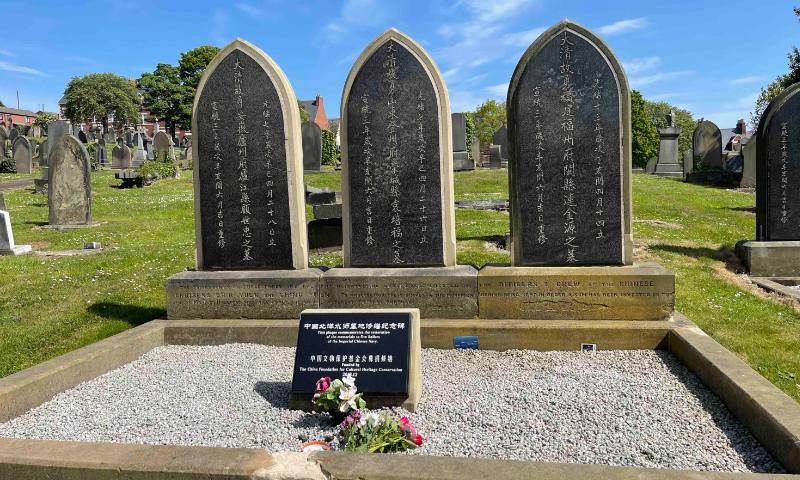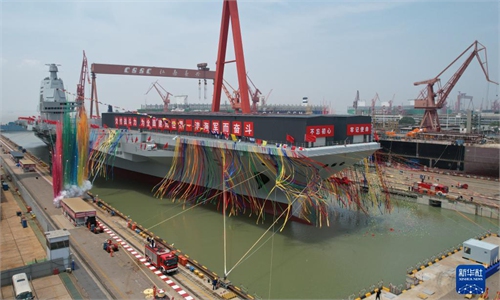Overseas Chinese commemorate seamen buried in the UK with photos of China's 3rd aircraft carrier

Chinese Beiyang Fleet Sailors' Memorial in Newcastle, UK Photo: Courtesy of Echelle Wang
Shortly after China launched the Fujian, the country's third aircraft carrier, the good news flew thousands of miles to the memorial of Chinese heroes in foreign lands with many overseas Chinese bringing photos of the Fujian to honor the sailors buried at the Chinese Beiyang Fleet Sailors' Memorial in Newcastle, the UK.
On June 17, China's third aircraft carrier and also its second domestically developed one, the Fujian, was launched in Shanghai. The ship, with a displacement of more than 80,000 tons, is the country's first carrier equipped with electromagnetic catapults and arresting devices.
The move was seen by experts as a milestone in the vessel's construction and future commissioning.
Upon learning the good news, many Chinese in the UK or other European countries visited the Beiyang Fleet Sailors' Memorial in Newcastle, carrying photos of the ship and other advanced weaponry and the national flag, paying tribute to the heroes that sacrificed their lives and were buried in a foreign land while fighting to build up the naval forces of their motherland.
The memorial, located in St John's Cemetery, contains the remains of Yuan Peifu, Gu Shizhong, Lian Jinyuan, Chen Shoufu and Chen Chengkui, five Chinese sailors and part of the first two naval delegations that China sent to Europe who died in Newcastle in the 1880s.
The five tombstones, all in Chinese style, stand back from the local tombstones, facing east as if looking far away to their homeland.
Echelle Wang, a PhD student in the UK, told the Global Times on Sunday that she recently visited the memorial with one picture of China's third aircraft carrier and a screenshot of Yang Jiechi, a member of the Political Bureau of the Communist Party of China (CPC) Central Committee and director of the Office of the Foreign Affairs Commission of the CPC Central Committee. Yang told the American side during the Alaska talks that the US is not qualified to speak to China from a position of strength.
"I have long planned to visit the place and pay tribute to our national heroes as early as 2019 but the pandemic made me postpone the visit until this year," Wang said. "I was quite emotional while on my way there. It should have been a long and hard journey for those soldiers when they went all the way from China to England to buy warships, and died in a foreign land unable to return to their roots. Living in the 21st century, it is unimaginable the shame they had gone through when facing the invaders at that time," Wang mentioned.
"I hope that they will know that China is no longer that poor and weak country during the First Sino-Japanese War and the Opium War. Today, the Chinese people are able to live in abundance and prosperity," she remarked.
The tombs are considered to be of historical significance that mark the birth of the Beiyang, or Northern Fleet, the most powerful naval force assembled by China during the Qing Dynasty (1644-1911), which was bolstered by four battle cruisers China bought from Britain.
In 1881 and 1887, the government of the Qing Dynasty sent hundreds of sailors of the Beiyang Fleet to Newcastle to bring back the cruisers China bought from Britain. Five young sailors died during the mission.
Weathering through more than 100 years of wind and rain, the graves of the sailors were dilapidated and the gravestones collapsed but in 2019 they were successfully restored.
Speaking at the restoration ceremony, the Chinese Embassy in the UK said that "in commemorating the five Beiyang Fleet sailors and revisiting China's modern history, one should never forget the national humiliation and should make every effort to achieve the Chinese dream of realizing the great rejuvenation of the Chinese nation."


